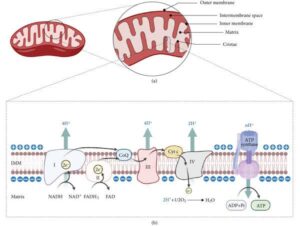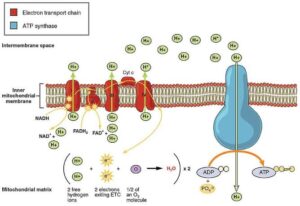Back to: MICROBIOLOGY 200 LEVEL
Welcome to class!
Hi brilliant learner! I’m so glad you’re here again. Every time you show up, you’re building your knowledge step by step like a true scientist. Today’s lesson is about something very important that powers life in all cells: the Electron Transport Chain, or ETC for short. It might sound like a big phrase, but don’t worry—we’ll make it simple, relatable, and even enjoyable. So let’s get started!
Structure And Function Of Etc
What is the Electron Transport Chain (ETC)?
The Electron Transport Chain is like the final lap in a relay race—the point where cells produce the most energy (ATP). It is the last stage of respiration, and it happens in the cell membrane of prokaryotes and the inner mitochondrial membrane of eukaryotic cells.

Think of it as a power station where electrons (from earlier steps like glycolysis or the Krebs cycle) are passed along a chain of proteins to generate energy.
Structure of the ETC
The ETC is made up of a series of protein complexes and mobile electron carriers. Each one plays a specific role. Let’s look at the key parts:
Complex I (NADH dehydrogenase) – This takes electrons from NADH and passes them into the chain.
Complex II (Succinate dehydrogenase) – Accepts electrons from FADH₂.
Ubiquinone (coenzyme Q) – A small molecule that moves electrons between Complex I/II to Complex III.
Complex III (Cytochrome bc₁ complex) – Passes electrons to cytochrome c.
Cytochrome c – A mobile carrier that moves electrons to Complex IV.
Complex IV (Cytochrome c oxidase) – Passes electrons to oxygen, which combines with hydrogen to form water.
While electrons are passed from one complex to another, protons (H⁺ ions) are pumped out of the membrane, creating a proton gradient.
Function of the ETC
Now, this is where the magic happens:
As electrons move through the chain, energy is released.
This energy is used to pump protons (H⁺) across the membrane.
The build-up of protons creates a proton gradient—like water behind a dam.
The protons then flow back through a special enzyme called ATP synthase, which uses their flow to make ATP.
This process is called oxidative phosphorylation, and it produces about 34 ATP per glucose molecule—the highest energy output of all respiration stages.
Imagine a hydroelectric dam. Water (protons) is stored at the top, and as it flows down through turbines (ATP synthase), electricity (ATP) is generated. The ETC is like that dam, using the “flow” to power the cell.
Why is the ETC Important?
It makes most of the ATP your body uses every second.

It helps remove used electrons by passing them to oxygen.
It keeps the energy cycle going smoothly.
In microbes, it helps them survive and grow efficiently.
Summary
- The Electron Transport Chain (ETC) is the final stage of respiration.
- It’s located in the inner mitochondrial membrane (or cell membrane in bacteria).
- It uses electrons from NADH and FADH₂ to pump protons and generate ATP.
- ATP synthase uses the proton gradient to produce energy.
- The final electron acceptor in aerobic respiration is oxygen, which forms water.
Evaluation
- Where does the Electron Transport Chain occur in eukaryotic cells?
- What is the main purpose of the ETC?
- Name one mobile electron carrier in the ETC.
- What is the final electron acceptor in aerobic respiration?
Well done, science star! You’ve just unlocked one of the most powerful secrets of life—how cells generate the energy they need to function. Never forget, just like the ETC powers cells, your determination and focus are powering your success. Keep learning with Afrilearn—you’re doing amazing things. See you in the next class, my champ!
